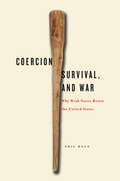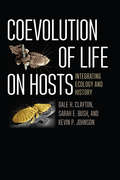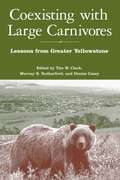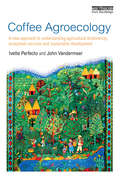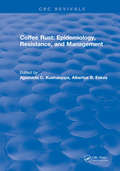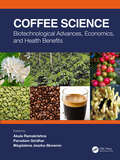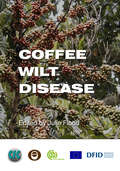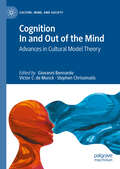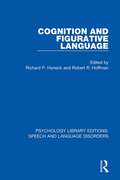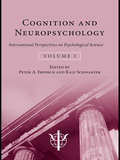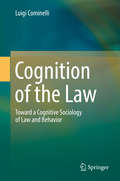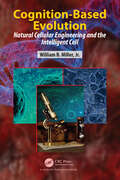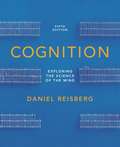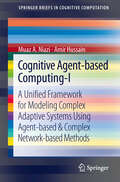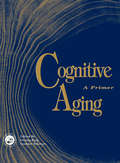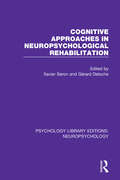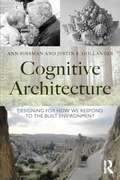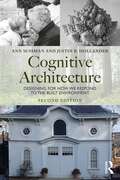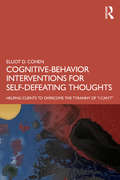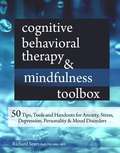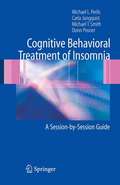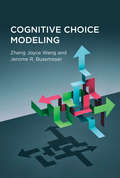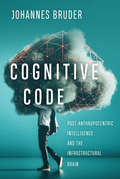- Table View
- List View
Coercion, Survival, and War: Why Weak States Resist the United States
by Phil HaunIn asymmetric interstate conflicts, great powers have the capability to coerce weak states by threatening their survival--but not vice versa. It is therefore the great power that decides whether to escalate a conflict into a crisis by adopting a coercive strategy. In practice, however, the coercive strategies of the U. S. have frequently failed. In Coercion, Survival and War Phil Haun chronicles 30 asymmetric interstate crises involving the US from 1918 to 2003. The U. S. chose coercive strategies in 23 of these cases, but coercion failed half of the time: most often because the more powerful U. S. made demands that threatened the very survival of the weak state, causing it to resist as long as it had the means to do so. It is an unfortunate paradox Haun notes that, where the U. S. may prefer brute force to coercion, these power asymmetries may well lead it to first attempt coercive strategies that are expected to fail in order to justify the war it desires. He concludes that, when coercion is preferred to brute force there are clear limits as to what can be demanded. In such cases, he suggests, U. S. policymakers can improve the chances of success by matching appropriate threats to demands, by including other great powers in the coercive process, and by reducing a weak state leader's reputational costs by giving him or her face saving options.
Coevolution of Life on Hosts: Integrating Ecology and History (Interspecific Interactions Ser.)
by Dale H. Clayton Kevin P. Johnson Sarah E. BushFor most, the mere mention of lice forces an immediate hand to the head and recollection of childhood experiences with nits, medicated shampoos, and traumatic haircuts. But for a certain breed of biologist, lice make for fascinating scientific fodder, especially enlightening in the study of coevolution. In this book, three leading experts on host-parasite relationships demonstrate how the stunning coevolution that occurs between such species in microevolutionary, or ecological, time generates clear footprints in macroevolutionary, or historical, time. By integrating these scales, Coevolution of Life on Hosts offers a comprehensive understanding of the influence of coevolution on the diversity of all life. Following an introduction to coevolutionary concepts, the authors combine experimental and comparative host-parasite approaches for testing coevolutionary hypotheses to explore the influence of ecological interactions and coadaptation on patterns of diversification and codiversification among interacting species. Ectoparasites—a diverse assemblage of organisms that ranges from herbivorous insects on plants, to monogenean flatworms on fish, and feather lice on birds—are powerful models for the study of coevolution because they are easy to observe, mark, and count. As lice on birds and mammals are permanent parasites that spend their entire lifecycles on the bodies of their hosts, they are ideally suited to generating a synthetic overview of coevolution—and, thereby, offer an exciting framework for integrating the concepts of coadaptation and codiversification.
Coexisting with Large Carnivores: Lessons From Greater Yellowstone
by Murray Rutherford Denise Casey Tim ClarkAs in the rest of the United States, grizzly bears, wolves, and mountain lions in and around Yellowstone National Park were eliminated or reduced decades ago to very low numbers. In recent years, however, populations have begun to recover, leading to encounters between animals and people and, more significantly, to conflicts among people about what to do with these often controversial neighbors. Coexisting with Large Carnivores presents a close-up look at the socio-political context of large carnivores and their management in western Wyoming south of Yellowstone National Park, including the southern part of what is commonly recognized as the Greater Yellowstone Ecosystem. The book brings together researchers and others who have studied and worked in the region to help untangle some of the highly charged issues associated with large carnivores, their interactions with humans, and the politics that arise from those interactions. This volume argues that coexistence will be achieved only by a thorough understanding of the human populations involved, their values, attitudes, beliefs, and the institutions through which carnivores and humans are managed. Coexisting with Large Carnivores offers important insights into this complex, dynamic issue and provides a unique overview of issues and strategies for managers, researchers, government officials, ranchers, and everyone else concerned about the management and conservation of large carnivores and the people who live nearby.
Coffee Agroecology: A New Approach to Understanding Agricultural Biodiversity, Ecosystem Services and Sustainable Development
by Ivette Perfecto John VandermeerBased on principles of the conservation and optimization of biodiversity and of equity and sustainability, this book focuses on the ecology of the coffee agroecosystem as a model for a sustainable agricultural ecosystem. It draws on the authors' own research conducted over the last twenty years as well as incorporating the vast literature that has been generated on coffee agroecosystems from around the world. The book uses an integrated approach that weaves together various lines of research to understand the ecology of a very diverse tropical agroforestry system. Key concepts explored include biodiversity patterns, metapopulation dynamics and ecological networks. These are all set in a socioeconomic and political framework which relates them to the realities of farmers' livelihoods. The authors provide a novel synthesis that will generate new understanding and can be applied to other examples of sustainable agriculture and food production. This synthesis also explains the ecosystem services provided by the approach, including the economic, fair trade and political aspects surrounding this all-important global commodity.
Coffee Rust: Epidemiology, Resistance and Management
by Ajjamada C. KushalappaThis highly informative monograph will provide a basic reference on coffee rust for both investigators in the field and those entering it. The research conducted has been organized based on principles of epidemiology and plant disease management, providing both theoretical and practical information. This approach enables discussion of the past, present and future of coffee rust research in broad plant patholog-ical areas of biology, epidemiology, genetics and breeding for disease resistance, fungicide technology and application, and disease management. In addition, an analysis of epidemics, breeding programs, and other rust management practices in India, Kenya and Brazil are included. This new text will contain over 45 figures and 40 tables for both investigators in the field and those just entering it.
Coffee Science: Biotechnological Advances, Economics, and Health Benefits
by Akula Ramakrishna Magdalena Jeszka-Skowron Parvatam GiridharCoffee Science: Biotechnological Advances, Economics and Health Benefits highlights the important advances in coffee research and an all-inclusive collection of information on the current status of global coffee production and market, sustainable benefits, novel methods and recent developments in coffee metabolites analysis, advancements in coffee processing technology and improvement of coffee quality by fermentation, solid-liquid extraction methods, and post-harvesting processes to improve the beverage quality and produce coffees with different sensory profiles. The book compiles insights into the biotechnological advances to improve coffee quality. It also describes specialty coffees, which are gaining consumer acceptance and enjoying a good global market. This book collates work on the influence of various coffee metabolites such as methyl xanthine, polyphenols, phenolic compounds, indoleamines, biogenic amines, and coffee diterpenes in human health effects such as cardiovascular diseases, cancer, type 2 diabetes mellitus, Alzheimer’s disease, and Parkinson’s disease. This book is a useful resource for scientists, academicians, and professionals all over the world who are engaged in coffee cultivation, research, business and coffee consumers’ health. Key Features Current status on coffee production and the global market Novel methods and recent developments in the determination of coffee metabolites Advancements in coffee bean processing technology and improvement of coffee quality Biotechnological advances to improve coffee quality: The role of molecular markers, tissue culture, transgenic technology, and micro RNAs Effects of coffee consumption on human health Knowledge contributions from acknowledged experts from across the world
Coffee Wilt Disease
by Julie FloodCoffee Wilt Disease has cost African coffee farmers an estimated $1 billion to date, resulting from reduced yields and the extra costs incurred in trying to manage the disease.
Coffee, Tea, Chocolate, and the Brain (Nutrition, Brain And Behavior Ser. #Vol. 2)
by Astrid NehligCoffee, tea, and chocolate are among the most frequently consumed products in the world. The pleasure that many experience from these edibles is accompanied by a range of favorable and adverse effects on the brain that have been the focus of a wealth of recent research. Coffee, Tea, Chocolate, and the Brain presents new information on the
Cognition In and Out of the Mind: Advances in Cultural Model Theory (Culture, Mind, and Society)
by Victor C. de Munck Giovanni Bennardo Stephen ChrisomalisThis edited collection presents an agenda for the interdisciplinary study of anthropology and cognitive science. It consists of fifteen chapters written by international experts on the relationship between culture and cognition. This volume is unique in that it includes both inside (i.e., shared mental templates) and outside (i.e., extended, embedded, enactive and ecological) theories of cognition. The contributors come from the diverse disciplinary fields of anthropology, linguistics, archaeology, and cognitive science. The aim is to investigate the mental production of shared knowledge, goals, and desires around which human social life revolves. The coverage spans cultural and linguistic evolution, the importance of local histories, and the role of cultural models to understand and interact with the world. Drawing on cultural model theory, this volume is an invaluable resource for linguists, cognitive scientists, anthropologists, and other social scientists willing to explore and understand how the sharedness of culture can bond us all together across relative cultural differences and (mis)perceived divisions.
Cognition and Figurative Language (Psychology Library Editions: Speech and Language Disorders)
by Robert R. Hoffman Richard P. HoneckOriginally published in 1980, this is a book about the psychology of figurative language. It is however, eclectic and therefore should be of interest to professionals and students in education, linguistics, philosophy, sociolinguistics, and other concerned with meaning and cognition. The editors felt there was a pressing need to bring together the growing empirical efforts of this topic. In a sense, recognition of the theoretical importance of figurative language symbolized the transition from the psycholinguistics of the 1960s to that of the late 1970s, that is from a linguistic semantics to a more comprehensive psychological semantics with a healthy respect for context, inference, world knowledge, and above all creative imagination. The organization of the volume reflects the more basic, general concerns with cognition – from historical and philosophical background, through problems of mental representation and semantic theory, to developmental trends, and to applications in problem solving.
Cognition and Neuropsychology: International Perspectives on Psychological Science (Volume 1)
by Peter A. FrenschThis is the first of two volumes which together present the main contributions from the 29th International Congress of Psychology, held in Berlin in 2008, written by international leaders in psychology from around the world. The authors present a variety of approaches and perspectives that reflect cutting-edge advances in psychological science. Cognition and Neuropsychology is dedicated to summarizing and characterizing the current scientific research in three substantive content areas, (i) Perception, Attention, and Action, (ii) Social Cognition, and (iii) Learning, Memory and Development. While some of the contributions focus on relatively narrow areas of research, others adopt a much broader stance, trying to understand and explain many different facets of behaviour across widely differing situations. Some contributions even try to bridge the fundamental gap between behaviour and genetics. The final part contains two chapters that discuss fundamental general issues in psychology, such as the fate of mentalism and the significance of phenomenal analyses. All chapters offer fascinating insights into current theorizing on the mind, and are written by some of the best-known scholars of our time. This book will be an invaluable resource for researchers, professionals, teachers and students in the field of psychology.
Cognition and the Brain
by Andrew Brook Kathleen AkinsAn up-to-date and comprehensive overview of the philosophy and neuroscience movement.
Cognition of the Law: Toward a Cognitive Sociology of Law and Behavior
by Luigi CominelliThis book’s basic hypothesis – which it proposes to test with a cognitive-sociological approach – is that legal behavior, like every form of human behavior, is directed and framed by biosocial constraints that are neither entirely genetic nor exclusively cultural. As such, from a sociological perspective the law can be seen as a super-meme, that is, as a biosocial constraint that develops only in complex societies. This super-meme theory, by highlighting a fundamental distinction between defensive and assertive biases, might explain the false contradiction between law as a static and historical phenomenon, and law as a dynamic and promotional element. Socio-legal scholars today have to face the challenge of pursuing a truly interdisciplinary approach, connecting all the fields that can contribute to building a modern theory of normative behavior and social action. Understanding and framing concepts such as rationality, emotion, or justice can help to overcome the significant divide between micro and macro sociological knowledge. Social scientists who are interested in the law must be able to master the epistemological discourses of different disciplines, and to produce fruitful syntheses and bridge-operations so as to understand the legal phenomenon from each different point of view. The book adopts four perspectives: sociological, psychological, biological-evolutionary and cognitive. All of them have the potential to be mutually integrated, and constitute that general social science that provides common ground for exchange. The goal is to arrive at a broad and integrated view of the socio-legal phenomenon, paving the way for a comprehensive theory of norm-oriented and norm-perceived actions.
Cognition-Based Evolution: Natural Cellular Engineering and the Intelligent Cell
by William B. MillerCognition-Based Evolution is the first comprehensive alternative to 20th-century Neodarwinism, proposing a radical 21st-century evolutionary framework with a novel point of origination: all cells are intelligent and must measure uncertain environmental information to sustain themselves. In Cognition-Based Evolution, life is defined by cognition. From this differential stance, evolutionary biology transforms into the science of why, how, what, and with whom cells measure and communicate under stressful environmental conditions. Life's context is uncertain environmental information, communication is its means, and genes are its tools. Evolution is its yield as continuous non-random self-referential cellular problem-solving.
Cognition: Exploring the Science of the Mind (Fifth Edition)
by Daniel ReisbergCognition uses the best of current research to help students think like psychologists and understand how cognitive psychology is relevant to their lives. The Fifth Edition offers a streamlined presentation, introduces an attractive new full-color design and an expanded art program, and has been thoughtfully updated with the best of current research.
Cognitive Agent-based Computing-I: A Unified Framework for Modeling Complex Adaptive Systems using Agent-based & Complex Network-based Methods (SpringerBriefs in Cognitive Computation #1)
by Amir Hussain Muaz A NiaziComplex Systems are made up of numerous interacting sub-components. Non-linear interactions of these components or agents give rise to emergent behavior observable at the global scale. Agent-based modeling and simulation is a proven paradigm which has previously been used for effective computational modeling of complex systems in various domains. Because of its popular use across different scientific domains, research in agent-based modeling has primarily been vertical in nature. The goal of this manuscript is to provide a single hands-on guide to developing cognitive agent-based models for the exploration of emergence across various types of complex systems. We present practical ideas and examples for researchers and practitioners for the building of agent-based models using a horizontal approach - applications are demonstrated in a number of exciting domains as diverse as wireless sensors networks, peer-to-peer networks, complex social systems, research networks, epidemiological HIV
Cognitive Aging: A Primer
by Norbert Schwarz Denise C. ParkAs our society ages, the topic of cognitive aging is becoming increasingly important. This volume provides an accessible overview of how the cognitive system changes as a function of normal aging.Building on the successful first edition, this volume provide an even more comprehensive coverage of the major issues affecting memory, attention, language, speech and other aspects of cognitive functioning. The essential chapters from the first edition have been thoroughly revised and updated and new chapters have been introduced which draw in neuroscience studies and more applied topics. In addition, contributors were encouraged to ensure their chapters are accessible to students studying the topic for the first time. This therefore makes the volume appealing as a textbook on senior undergraduate and graduate courses.
Cognitive Approaches in Neuropsychological Rehabilitation (Psychology Library Editions: Neuropsychology #11)
by Xavier Seron Gérard DelocheOriginally published in 1989, presenting a new perspective on cognitive therapy in neuropsychology, these papers examine a cognitively-oriented, single-case methodology in neuropsychological rehabilitation. The recommended strategy is in-depth analysis of the precise nature of the impaired as well as the preserved processing components in the individual patient. The objective is to design a therapeutic course based on individual patient needs that is justified by the theoretical interpretation of the location of the deficit in his or her cognitive architecture.
Cognitive Architecture: Designing for How We Respond to the Built Environment
by Ann Sussman Justin B Hollander*Winner of the Environmental Design Research Association 2016 Place Research Award!* In Cognitive Architecture, the authors review new findings in psychology and neuroscience to help architects and planners better understand their clients as the sophisticated mammals they are, arriving in the world with built-in responses to the environment that have evolved over millennia. The book outlines four main principles---Edges Matter, the fact people are a thigmotactic or a 'wall-hugging' species; Patterns Matter, how we are visually-oriented; Shapes Carry Weight, how our preference for bilateral symmetrical forms is biological; and finally, Storytelling is Key, how our narrative proclivities, unique to our species, play a role in successful place-making. The book takes an inside-out approach to design, arguing that the more we understand human behavior, the better we can design for it. The text suggests new ways to analyze current designs before they are built, allowing the designer to anticipate a user's future experience. More than one hundred photographs and drawings illustrate its key concepts. Six exercises and additional case studies suggest particular topics - from the significance of face-processing in the human brain to our fascination with fractals - for further study.
Cognitive Architecture: Designing for How We Respond to the Built Environment
by Ann Sussman Justin B HollanderIn this expanded second edition of Cognitive Architecture, the authors review new findings in psychology and neuroscience to help architects and planners better understand their clients as the sophisticated mammals they are, arriving in the world with built-in responses to the environment. Discussing key biometric tools to help designers ‘see’ subliminal human behaviors and suggesting new ways to analyze designs before they are built, this new edition brings readers up-to-date on scientific tools relevant for assessing architecture and the human experience of the built environment. The new edition includes: Over 100 full color photographs and drawings to illustrate key concepts. A new chapter on using biometrics to understand the human experience of place. A conclusion describing how the book’s propositions reframe the history of modern architecture. A compelling read for students, professionals, and the general public, Cognitive Architecture takes an inside-out approach to design, arguing that the more we understand human behavior, the better we can design and plan for it.
Cognitive Behavior Interventions for Self-Defeating Thoughts: Helping Clients to Overcome the Tyranny of “I Can’t”
by Elliot D. CohenIntegrating Cognitive Behavior Therapy (CBT) with a logic-based restructuring of Rational Emotive Behavioral Therapy (REBT), this book provides therapists with a guide for addressing self-defeating thoughts and behaviors. Cohen explores how the tyrannical use of the words "I can’t" creates and sustains many commonplace behavioral and emotional problems. It shows how cognition and affect are intimately connected, demonstrating how cognitive-behavioral interventions help clients to address both their feelings and irrational ideas. Each chapter explores a specific problem, including low frustration tolerance, obsessiveness, risk avoidance, phobias, intolerance to criticism, dependent personalities, and much more. The theories developed throughout are integrated with practice sections and session transcripts that focus on the application of these theories for the treatment of clients who have self-destructive linguistic habits. Cohen also provides resource materials including reflection activities, bibliotherapy, meditation, and step-by-step guidance. This book is essential reading for mental health professionals looking for novel techniques of using CBT, life coaches, positive psychology coaches, counsellors, and academic and clinical researchers who work with CBT.
Cognitive Behavioral Therapy & Mindfulness Toolbox: 50 Tips, Tools And Handouts For Anxiety, Stress, Depression, Personality And Mood Disorders
by Richard SearsCognitive Behavioral Therapy (CBT) has been an effective intervention for decades, but few clinicians have discovered the powerful treatment results of combining CBT with Mindfulness. Clinical psychologist and mindfulness expert Dr. Richard Sears has created a practical, engaging skills manual that clearly defines the principles of CBT and then demonstrates steps for integrating mindfulness practices into therapy -- all drawing from the latest research. Straight-forward explanations and dozens of worksheets provide fresh insights and new tools to move therapy forward when treating stress, anxiety, panic, depression, pain, trauma, addictions, and other issues.
Cognitive Behavioral Treatment of Insomnia: A Session-by-Session Guide
by Carla Jungquist Donn Posner Michael T. Smith Michael L. PerlisCognitive behavior therapy which has been adapted to treat so many problems, has also brought data-driven and data-yielding treatment to insomnia. Focusing on this evidence-based modality, Cognitive Behavioral Treatment of Insomnia is a much-needed treatment manual that provides clinicians with the why’s and how’s of this approach in concise and practical terms. This book, which is written as a reader-friendly guide, is intended for clinical trainees, non-insomnia sleep specialists, and for expert CBT clinicians from outside the sleep medicine field who wish to begin the process of learning to provide empirically validated CBT-I.
Cognitive Choice Modeling
by Jerome R. Busemeyer Zheng Joyce WangThe emerging interdisciplinary field of cognitive choice models integrates theory and recent research findings from both decision process and choice behavior.Cognitive decision processes provide the interface between the environment and brain, enabling choice behavior, and the basic cognitive mechanisms underlying decision processes are fundamental to all fields of human activity. Yet cognitive processes and choice processes are often studied separately, whether by decision theorists, consumer researchers, or social scientists. In Cognitive Choice Modeling, Zheng Joyce Wang and Jerome R. Busemeyer introduce a new cognitive modeling approach to the study of human choice behavior. Integrating recent research findings from both cognitive science and choice behavior, they lay the groundwork for the emerging interdisciplinary field of cognitive choice modeling.
Cognitive Code: Post-Anthropocentric Intelligence and the Infrastructural Brain
by Johannes BruderAs the second decade of the twenty-first century draws to a close, the cultural, social, and economic effects of artificial intelligence are becoming ever more apparent. Despite their long-intertwined histories, the fields of neuroscience and artificial intelligence research are notoriously divided. In Cognitive Code Johannes Bruder argues that seemingly incompatible scales of intelligence – the brain and the planet – are now intimately linked through neuroscience-inspired AI and computational cognitive neuroscience. Building on ethnographic fieldwork in brain imaging labs in the United Kingdom and Switzerland, alongside analyses of historical and contemporary literature, Cognitive Code examines how contemporary research on the brain makes routine use of engineering epistemologies and practices. Bruder elaborates on how the question of mimicking human cognition and thought on the scale of computer chips and circuits has gradually evolved into a comprehensive restructuring of the world through "smart" infrastructures. The brain, traditionally treated as a discrete object that thinks, is becoming part of the larger thinking network we now know as "the Cloud." The author traces a recent shift in the goals of brain imaging to show that the introduction of novel statistical and computational techniques has upset traditional paradigms and disentangled cognition from its biological substrate. Investigating understandings of intelligence from the micro to the macro, Cognitive Code explains how the future of human psychology is increasingly determined by engineering and design.
